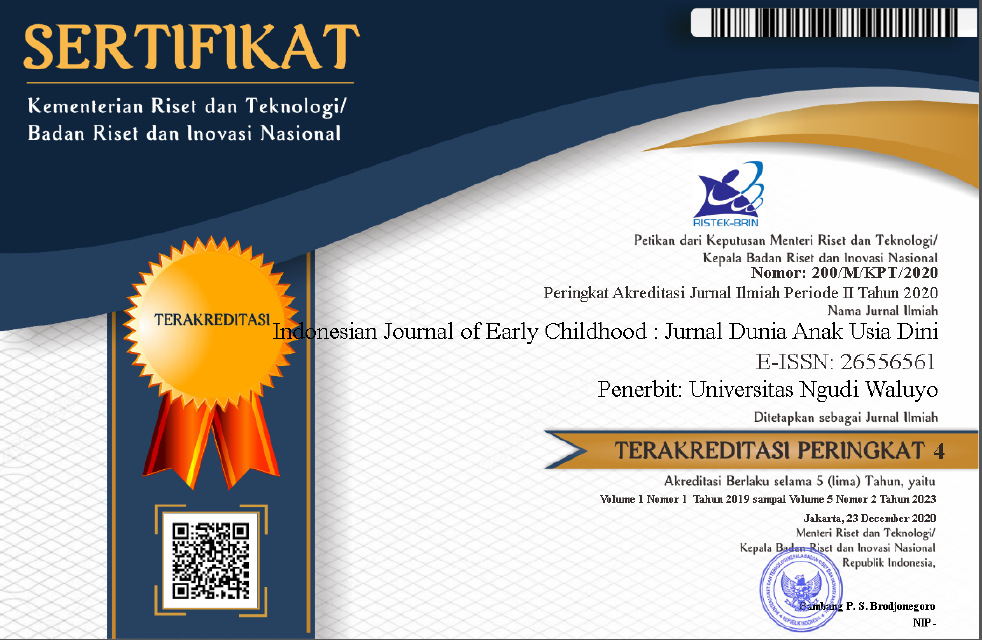Analisis Creative Problem Solving (CPS) pada Anak Berbakat (Gifted And Talented Children) di Usia Prasekolah
Analysis Of Creative Problem Solving in Gifted and Talented Children at Preschool Age
DOI:
https://doi.org/10.35473/ijec.v7i1.3607Keywords:
Creative Problem Solving, CPS, Gifted and Talented Children, PreschoolAbstract
Gifted & Talented Children demonstrate abilities or potential that are far above average in one or more specific areas, such as academics, arts, or sports. The development of Creative Problem-Solving Skills in gifted children is key to forming the foundation of problem-solving abilities that will support children throughout their lives. This study examines how the development of CPS in gifted children at preschool age through reputable articles. This study uses a systematic literature review method with the PRISMA (Preferred Reporting Items for Systematic Reviews and Meta-Analyses) flow. The data obtained were analyzed using an Interactive qualitative data analysis model with the help of NVIVO 12 software. Literature was taken from reputable databases such as Scopus, Springer, Sciendirect, DOAJ and Google Scholar databases. There are 4 steps to conducting a literature review, namely: identifying the topic/issue to be reviewed (identification), selecting similar articles (screening), analyzing literature that meets the appropriate requirements (eligibility), compiling a review writing (included). The results of the study showed that there are several factors that influence the development of CPS in gifted children at preschool age, including family environment, parenting patterns, learning methods obtained at school, social interactions with peers, and psychological factors including emotional intelligence and motivation.
ABSTRAK
Anak berbakat (Gifted & Talented Children) menunjukkan kemampuan atau potensi yang jauh di atas rata-rata dalam satu atau lebih pada bidang tertentu, seperti akademik, seni, atau olahraga. Perkembangan Keterampilan Pemecahan Masalah Kreatif (Creative Problem Solving) pada anak berbakat menjadi kunci untuk membentuk dasar kemampuan pemecahan masalah yang akan mendukung anak sepanjang hidup. Penelitian ini mengkaji bagaimana perkembangan CPS anak berbakat pada usia prasekolah melalui artikel bereputasi. Penelitian ini menggunakan metode tinjauan literatur sistematik (Systematic Literature Review) dengan alur PRISMA (Preferred Reporting Items for Systematic Reviews and Meta-Analyses). Data yang diperoleh dianalisis menggunakan model analisis data kualitatif Interaktif dengan bantuan perangkat lunak NVIVO 12. Literatur diambil melalui database beriputasi seperti dari database Scopus, Springer, Sciendirect, DOAJ dan Google Scholar. Ada 4 langkah untuk melakukan tinjauan literatur yaitu: mengidentifikasi topik/isu yang akan di telaah (identification), memilih artikel yang sejenis (screening), menganalisis literatur yang sesui persyartan yang sesuai (eligibility), menyusun penulisan review (included). Hasil penelitian menunjukkan bahwa terdapat beberapa factor yang mempengaruhi perkembangan CPS anak berbakat pada usia prasekolah diantaranya lingkungan keluarga, pola asuh, metode pembelajaran yang didapatkan disekolah, interaksi sosial dengan teman sebaya, dan faktor psikologis termasuk kecerdasan emosional dan motivasi.
References
Adams, J. P., Kaczmarczyk, S., Picton, P., & Demian, P. (2010). Problem Solving and Creativity in Engineering: Conclusions of a Three Year Project Involving Reusable Learning Objects and Robots. Engineering Education, 5(2), 4–17. https://doi.org/10.11120/ened.2010.05020004
Alhayat, A. (2023). Evaluation of Science Curriculum: A Literature Study. Inovasi Kurikulum, 20(2), 239–250. https://doi.org/10.17509/jik.v20i2.58887
Andrian, R., Yasin, A., Hanan, M. R. I., Ramadhan, M. I., Ridwan, T., & Hikmawan, R. (2022). Development of a Digital Platform Prototype, to Facilitate Inclusive Learning for Children With Special Needs. Jurnal Online Informatika, 7(2), 161–167. https://doi.org/10.15575/join.v7i2.835
Andriani, D., & Rakimahwati, R. (2023). Pengembangan Kreativitas Anak Usia Dini Menggunakan Media Berbasis Alam. Jurnal Obsesi : Jurnal Pendidikan Anak Usia Dini, 7(2), 1910–1922. https://doi.org/10.31004/obsesi.v7i2.4243
Aziz, A. R. A., Razak, N. H. A., Sawai, R. P., Kasmani, M. F., Amat, M. I., & Shafie, A. A. H. (2021). Exploration of Challenges Among Gifted and Talented Children. Malaysian Journal of Social Sciences and Humanities (Mjssh), 6(4), 242–251. https://doi.org/10.47405/mjssh.v6i4.760
Aziz, C. N. F. C. A., & Bakar, K. A. (2021). Fostering Children’s Creativity Through Preschool Stem Creativity Module. International Journal of Academic Research in Progressive Education and Development, 10(3). https://doi.org/10.6007/ijarped/v10-i3/10403
Bai, H., Duan, H., Kroesbergen, E. H., Leseman, P., & Hu, W. (2019). The Benefits of the Learn to Think Program for Preschoolers’ Creativity: An Explorative Study. The Journal of Creative Behavior, 54(3), 699–711. https://doi.org/10.1002/jocb.404
Barrett, J. D., Peterson, D. R., Hester, K. S., Robledo, I. C., Day, E. A., Hougen, D. P., & Mumford, M. D. (2013). Thinking About Applications: Effects on Mental Models and Creative Problem-Solving. Creativity Research Journal, 25(2), 199–212. https://doi.org/10.1080/10400419.2013.783758
Berezovska, L., Pyatnitska-Pozdnyakova, I., Tyurina, V., Mordovtseva, N., Pylaieva, T., & Karakoz, O. (2021). Use of Problem-Based Learning Technology in Institutions of Higher Education. Laplage Em Revista, 7(Extra-E), 122–132. https://doi.org/10.24115/s2446-622020217extra-e1168p.122-132
Bianco, M., & Leech, N. L. (2010). Twice-Exceptional Learners: Effects of Teacher Preparation and Disability Labels on Gifted Referrals. Teacher Education and Special Education the Journal of the Teacher Education Division of the Council for Exceptional Children, 33(4), 319–334. https://doi.org/10.1177/0888406409356392
Boer, G. C. d., Minnaert, A., & Kamphof, G. (2013). Gifted Education in the Netherlands. Journal for the Education of the Gifted, 36(1), 133–150. https://doi.org/10.1177/0162353212471622
Chaidam, O., & Poonputta, A. (2022). Learning Achievement Improvement of 1st Grade Students by Using Problem-Based Learning (PBL) on TPACK MODEL. Journal of Education and Learning, 11(2), 43. https://doi.org/10.5539/jel.v11n2p43
Chen, X., & Cheng, L. J. (2023). Emotional Intelligence and Creative Self-Efficacy Among Gifted Children: Mediating Effect of Self-Esteem and Moderating Effect of Gender. Journal of Intelligence, 11(1), 17. https://doi.org/10.3390/jintelligence11010017
Cheung, R. H. P. (2018). Play-based creativity-fostering practices: the effects of different pedagogical approaches on the development of children’s creative thinking behaviours in a Chinese preschool classroom. Pedagogy, Culture and Society, 26(4), 511–527. https://doi.org/10.1080/14681366.2018.1424725
Cojorn, K., Koocharoenpisal, N., Haemaprasith, S., & Siripankaew, P. (2012). Enhancing the Creative Problem Solving Skill by Using the CPS Learning Model for Seventh Grade Students with Different Prior Knowledge Levels. Journal of The Korean Association For Science Education, 32(8), 1333–1344. https://doi.org/10.14697/jkase.2012.32.8.1333
Dereli, E., & Deli, H. (2022). Pre-school teachers’ knowledge and needs related to noticing gifted children and the enrichment model. Participatory Educational Research, 9(2), 219–239. https://doi.org/10.17275/per.22.37.9.2
Dong, Y., Zhu, S., & Li, W. (2021). Promoting sustainable creativity: An empirical study on the application of mind mapping tools in graphic design education. Sustainability (Switzerland), 13(10). https://doi.org/10.3390/su13105373
Dwisnu, E. (2021). Effect of Problem-Based Learning Strategy to Students’ Ability in Writing Argumentative Text at Muhammadiyah University of Bengkulu. Radiant, 2(2), 87–102. https://doi.org/10.52187/rdt.v2i2.41
Eklund, K., Tanner, N., Stoll, K., & Anway, L. (2015). Identifying emotional and behavioral risk among gifted and nongifted children: A multi-gate, multi-informant approach. School Psychology Quarterly, 30(2), 197–211. https://doi.org/10.1037/spq0000080
Elmanora, E., Hastuti, D., & Muflikhati, I. (2017). Lingkungan Keluarga sebagai Sumber Stimulasi Utama untuk Perkembangan Kognitif Anak Usia Prasekolah. Jurnal Ilmu Keluarga Dan Konsumen, 10(2), 143–156. https://doi.org/10.24156/jikk.2017.10.2.143
Fatmawati, B., Jannah, B. M., & Sasmita, M. (2022). Students’ Creative Thinking Ability Through Creative Problem Solving based Learning. Jurnal Penelitian Pendidikan IPA, 8(4), 2384–2388. https://doi.org/10.29303/jppipa.v8i4.1846
Gali, G. (2022). The Role of Family and School in Education of Gifted Children. https://doi.org/10.47696/adved.202202
Ganefri, G., Prasetya, F., Ranuharja, F., Fajri, B. R., & Samala, A. D. (2021). Development of Digital Multimedia Learning Content Mini Server Lentera. Jurnal Teknologi Informasi Dan Pendidikan, 13(2), 75–79. https://doi.org/10.24036/tip.v13i2.365
Garn, A. C., Matthews, M. S., & Jolly, J. L. (2010). Parental Influences on the Academic Motivation of Gifted Students: A Self-Determination Theory Perspective. Gifted Child Quarterly, 54(4), 263–272. https://doi.org/10.1177/0016986210377657
Downloads
Published
How to Cite
Issue
Section
License
Copyright (c) 2025 Indonesian Journal of Early Childhood: Jurnal Dunia Anak Usia Dini

This work is licensed under a Creative Commons Attribution-ShareAlike 4.0 International License.
Please find the rights and licenses in Indonesian Journal Of Early Childhood: Jurnal Dunia Anak Usia DIni. By submitting the article/manuscript of the article, the author(s) agree with this policy. No specific document sign-off is required.
1. License
The non-commercial use of the article will be governed by the Creative Commons Attribution license as currently displayed on Creative Commons Attribution-ShareAlike 4.0 International License.
2. Author(s)' Warranties
The author warrants that the article is original, written by stated author(s), has not been published before, contains no unlawful statements, does not infringe the rights of others, is subject to copyright that is vested exclusively in the author and free of any third party rights, and that any necessary written permissions to quote from other sources have been obtained by the author(s).
3. User Rights
Indonesian Journal Of Early Childhood: Jurnal Dunia Anak Usia Dini's spirit is to disseminate articles published are as free as possible. Under the Creative Commons license, Indonesian Journal Of Early Childhood: Jurnal Dunia Anak Usia Dini permits users to copy, distribute, display, and perform the work for non-commercial purposes only. Users will also need to attribute authors and Indonesian Journal Of Early Childhood: Jurnal Dunia Anak Usia Dini on distributing works in the journal and other media of publications.
4. Co-Authorship
If the article was jointly prepared by more than one author, any authors submitting the manuscript warrants that he/she has been authorized by all co-authors to be agreed on this copyright and license notice (agreement) on their behalf, and agrees to inform his/her co-authors of the terms of this policy. Indonesian Journal Of Early Childhood: Jurnal Dunia Anak Usia Dini will not be held liable for anything that may arise due to the author(s) internal dispute. Indonesian Journal Of Early Childhood: Jurnal Dunia Anak Usia Dini will only communicate with the corresponding author.
5. Miscellaneous
Indonesian Journal Of Early Childhood: Jurnal Dunia Anak Usia Dini will publish the article (or have it published) in the journal if the article’s editorial process is successfully completed. Indonesian Journal Of Early Childhood: Jurnal Dunia Anak Usia Dini's editors may modify the article to a style of punctuation, spelling, capitalization, referencing and usage that deems appropriate. The author acknowledges that the article may be published so that it will be publicly accessible and such access will be free of charge for the readers as mentioned in point 3.
Â
Every accepted manuscript should be accompanied by "Copyright Transfer Agreement" prior to the article publication.



